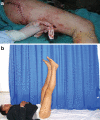Side-to-side neurorrhaphy for high-level peripheral nerve injuries
- PMID: 22231778
- PMCID: PMC3284681
- DOI: 10.1007/s00701-011-1264-2
Side-to-side neurorrhaphy for high-level peripheral nerve injuries
Abstract
Background: The results of peripheral nerve repair, especially for high-level peripheral nerve injuries, have been unsatisfactory. The method of side-to-side neurorrhaphy was developed in our laboratory from 1994 to 2002. This method involves suturing the injured nerve to a nearby donor nerve in a side-to-side manner. This study was performed to assess the clinical results of side-to-side neurorrhaphy in patients with high-level peripheral nerve injuries.
Methods: Twenty-five patients with various types of high-level peripheral nerve injuries who underwent side-to-side neurorrhaphy were studied. The British Medical Research Council (BMRC) scale was used to assess recovery of nerve function.
Results: Average follow-up duration was 3.2 years. Before surgery the patients had a nerve function of M0/S0 to M1/S1. After side-to-side neurorrhaphy, 7 patients had a score of M3/S4, 8 patients a score of M3/S3 and 10 patients a score of M2/S3. The total useful recovery rate (BMRC grade ≥3) was 60% for motor function and 100% for sensory function. Side-to-side neurorrhaphy did not result in any significant loss of donor nerve function. There was significant correlation between both the type of injury and the time interval between injury and surgery and motor nerve function. Age, gender and location of the injured nerve did not correlate with sensory or motor nerve function.
Conclusion: Side-to-side neurorrhaphy appears to be promising as a feasible method for repair of high-level peripheral nerve injuries.
Figures


Similar articles
-
Comparison of a distal end-to-side neurorrhaphy with a proximal-distal end-to-side neurorrhaphy: in a rat model.Eur J Orthop Surg Traumatol. 2015 Dec;25(8):1261-4. doi: 10.1007/s00590-015-1699-x. Epub 2015 Sep 7. Eur J Orthop Surg Traumatol. 2015. PMID: 26346962
-
End-to-side neurorrhaphy for nerve repair and function rehabilitation.J Surg Res. 2015 Aug;197(2):427-35. doi: 10.1016/j.jss.2015.03.100. Epub 2015 Apr 4. J Surg Res. 2015. PMID: 25979558
-
Surgery of the peripheral nerves.Bratisl Lek Listy. 2006;107(3):89-92. Bratisl Lek Listy. 2006. PMID: 16796131
-
End-to-side neurorrhaphy in peripheral nerves: Does it work?Hand Surg Rehabil. 2022 Feb;41(1):2-6. doi: 10.1016/j.hansur.2021.08.010. Epub 2021 Aug 28. Hand Surg Rehabil. 2022. PMID: 34464758
-
Approach to management of nerve gaps in peripheral nerve injuries.Injury. 2022 Apr;53(4):1308-1318. doi: 10.1016/j.injury.2022.01.031. Epub 2022 Jan 20. Injury. 2022. PMID: 35105440 Review.
Cited by
-
Outcome following nerve repair of high isolated clean sharp injuries of the ulnar nerve.PLoS One. 2012;7(10):e47928. doi: 10.1371/journal.pone.0047928. Epub 2012 Oct 17. PLoS One. 2012. PMID: 23082230 Free PMC article.
-
Protective distal side-to-side neurorrhaphy in proximal nerve injury-an experimental study with rats.Acta Neurochir (Wien). 2019 Apr;161(4):645-656. doi: 10.1007/s00701-019-03835-2. Epub 2019 Feb 12. Acta Neurochir (Wien). 2019. PMID: 30746570 Free PMC article.
-
Effect of Axonal Trauma on Nerve Regeneration in Side-to-side Neurorrhaphy: An Experimental Study.Plast Reconstr Surg Glob Open. 2016 Dec 22;4(12):e1180. doi: 10.1097/GOX.0000000000001180. eCollection 2016 Dec. Plast Reconstr Surg Glob Open. 2016. PMID: 28293524 Free PMC article.
-
Comparison of Peripheral Nerve Regeneration with Side-to-side, End-to-side, and End-to-end Repairs: An Experimental Study.Plast Reconstr Surg Glob Open. 2016 Dec 22;4(12):e1179. doi: 10.1097/GOX.0000000000001179. eCollection 2016 Dec. Plast Reconstr Surg Glob Open. 2016. PMID: 28293523 Free PMC article.
-
A combined inferior epigastric artery perforator propeller flap with scrotal flap for the reconstruction of a massive penoscrotal defect:A case report.Urol Case Rep. 2025 Jun 7;61:103092. doi: 10.1016/j.eucr.2025.103092. eCollection 2025 Jul. Urol Case Rep. 2025. PMID: 40547383 Free PMC article.
References
-
- Amr SM, Essam AM, Abdel-Meguid AM, Kholeif AM, Moharram AN, El-Sadek RE. Direct cord implantation in brachial plexus avulsions: revised technique using a single stage combined anterior (first) posterior (second) approach and end-to-side side-to-side grafting neurorrhaphy. J Brachial Plex Peripher Nerve Inj. 2009;4:8. doi: 10.1186/1749-7221-4-8. - DOI - PMC - PubMed
-
- Hong GX, Zheng Y, Wang FB, Wan SX, Chen ZB. The study on the nerve regeneration of end-to-side neurorrhaphy after peripheral nerve injury. Chinese J Hand Surg. 1998;14:42–44.
MeSH terms
LinkOut - more resources
Full Text Sources
Medical
Research Materials
Miscellaneous

